Serviços Personalizados
Artigo
Links relacionados
Compartilhar
Odontologia Clínico-Científica (Online)
versão On-line ISSN 1677-3888
Odontol. Clín.-Cient. (Online) vol.10 no.1 Recife Jan./Mar. 2011
ARTIGO ORIGINAL ORIGINAL ARTICE
Citologia esfoliativa convencional versus citologia em meio líquido para prevenção e diagnóstico precoce do carcinoma escamo celular (CEC) oral.
Conventional Cytology versus liquid-based cytology for prevention and early diagnosis of oral squamous cell carcioma (OSCC)
Aurora Karla de Lacerda VidalI; Arnaldo de França Caldas JúniorII; Roberto José Vieira de MelloIII; Vírginia Ribes Amorim BrandãoIV; Paula Abreu e LimaV; José Natal FigueiroaVI
IDepartment of Pathology, Biological Institute of University of Pernambuco - Brazil
IIDepartment of Preventive and Social Dentistry, School of Dentistry of University of Pernambuco - Brazil
IIIDepartment of Pathology, Cancer Hospital of Pernambuco and the Federal University of Pernambuco - Brazil
IVDepartment of Anatomic Pathology, School of Medicine of University of Pernambuco - Brazil
VDepartment of Pathology, Cancer Hospital of Pernambuco - Brazil
VIInfant Maternal Institute of Pernambuco - Brazil
RESUMO
Objetivando avaliar a concordância, sensibilidade e especificidade diagnóstica dos métodos citológicos: convencional e em meio líquido, foi realizado um estudo de caso-controle, no Ambulatório de Cabeça e Pescoço do Hospital de Câncer de Pernambuco, sendo selecionados 182 indivíduos doentes e 179 sãos, no período de setembro de 2002 a janeiro de 2004, os quais, permitiram através de assinatura de termo de consentimento livre e esclarecido a realização de exames (clínico/ citológico esfoliativo - cytobrush) na área carcinomatosa e em área sã, constituindo, respectivamente, o grupo de casos e controles. Os dados obtidos foram analisados através dos softwares estatísticos SPSS (Statistical Package for Social Science) e Epi-Info versão 6.4. Os resultados evidenciaram que os métodos diagnósticos citológicos apresentaram entre os casos: sensibilidade= 96,9% (IC= 95%: 92,5% a 98,8%); especificidade= 75,0% (IC= 95%: 21,9% a 98,7%) e acurácia= 96,3% (IC=95%: 92,5% a 98,5%); e entre os controles: sensibilidade= 91,0% (IC=95%: 84,1% a 95,2%); especificidade = 57,5% (IC=95%: 41,0% a 72,6%) e acurácia= 82,7% (IC=95%: 76,3% a 88,0%). A citologia convencional e em base-líquida apresentaram concordância com o diagnóstico histopatológico em mais de 90%. Conclui-se, portanto, que, se bem indicado e executado, o exame citológico pode ser utilizado rotineiramente como exame complementar, pois ambos apresentaram alta sensibilidade e razoável especificidade, cabendo à citologia convencional maior especificidade para o diagnóstico das lesões orais.
Descritores: Carcinoma Escamo Celular (CEC), Prevenção, Métodos Diagnósticos, Citologia Convencional, Citologia em meio líquido
ABSTRACT
The purpose of this study was to evaluate the sensitivity, specificity, and concordance between conventional cytology and liquid-based cytology. A case-control study was developed at the Head and Neck ambulatory service of Hospital do Cancer de Pernambuco. A hundred and eighty-two patients with primary Oral Squamous Cellular Carcinoma (OSCC) (case group) and 179 individuals with normal buccal mucosa (control group) were selected, from September 2002 to January 2004. They agreed to be submitted to clinical examination and exfoliative cytology of the oral cavity, by signing a document of consent. The data were analysed by Statistical Package for Social Science (SPSS) and Epi-Info 6.4 program. Among the cases, the cytologic methods demontrated a sensitivity= 96.9% (IC= 95%: 92.5% to 98.8%), specificity= 75.0% (IC=95%: 21.9% to 98.7%), and accuracy= 96.3% (IC=95%: 92.5% to 98.5%). Among the controls the results were: sensitivity= 91.0% (IC=95%: 84.1% to 95.2%);, specificity= 57.5% (IC=95%: 41.0% to 72.6%), and accuracy= 82.7% (IC=95%: 76.3% to 88.0%). Conventional cytology and liquid-based cytology demonstrated a diagnostic concordance with histopathology of more than 90%. In conclusion if properly indicated and executed, they can be routinely used as complementary diagnostic methods. When compared to each other, conventional cytology and liquid-based cytology showed a high sensitivity and reasonable specificity, conventional cytology having higher specificity.
Keywords: Oral Squamous Cell Carcinoma (OSCC), Prevention, Diagnostic Methods, Conventional Cytology, Liquid-based Cytology.
INTRODUCTION
Approximately 5% of all human cancers are localized in the mouth. More than 90% of them are squamous cell carcinomas that could be identified without the need for special techniques, since it is easily accessible by direct examination of the oral cavity. They are responsible for 99% of the deaths from oral cancer1,2,3,4,5 .
The need to increase the number of cases diagnosed at early stages has to be recognized as essential in order to provide real benefit for the patients. In this manner, the attention should be directed toward asymptomatic patients, so that an early diagnosis can be made6,7,8.
Conventional cytology, whose criteria were established by Papanicolaou9, is still widely employed. Many authors 7, 8, 10,11,12,13,14,15,16,17,18,19,20,21,22,23,24,25 defend it as a very useful diagnostic method in stomatology and in the study of material found on the suface of lesions. The latter helps clarify lesions found in pemphigus, herpes simplex, paracocciodiomycosis, actinomycosis, and candidiasis.
Exfoliative cytology is a simple method that could be added to the routine of all dental surgeons. This idea was defended by Christian26, who developed a preventive program with participation of dental surgeons and dental hygiene technicians. Vidal et al8 also included dentist assistants and health agents in programs aimed at making early diagnosis, identifying risk factors, and teaching how to perform self-examination.
Diagnostic cytology has contributed to tracking precursor as well as malignant lesions, with the identification of potentially fatal cases and the decrease in the impact of potentially irreversible lesions. It has shown to be efficient in detecting atypia also in ulcerated and non-ketatinizing lesions.
In countries (like Brazil) where preventive programs based on the Papanicolaou test have been largely implemented and continuously administered, the prevalence of cervical cancer decreased dramatically. As it has proved to be successful in the control of cervical cancer, we believe it can be employed in oral cancer for the same purpose.
Cytology in liquid medium (DNA-CITOLIQ), also referred to as "monolayer cytology", "thin-layer cytology", or preferentially "liquid sample cytology" or "liquid-based cytology", was idealized, developed and released in March 2002 by Digene do Brasil. The tests were conducted at UNIFESP and in eight Brazilian private laboratories. This method represents an improvement of Papanicolaou, and began a new era in cytology, connecting morphologic and biomolecular pathology. The studies performed on cervical samples demonstrated that the DNA-CITOLIQ System is sensitive for detecting epithelial lesions as well as microorganisms, with excellent results 27.
The purpose of this study was to evaluate and compare the sensitivity and specificity of conventional cytology and liquid-based cytology, as diagnostic tools employed in buccal malignant lesions and clinically normal mucosa.
MATERIALS AND METHODS
A case-control study was performed at the head and neck ambulatory service of Hospital do Câncer de Pernambuco, which is a reference center for oral cancer in the state of Pernambuco, serving rural, urban areas, and neighboring states.
The case group included 182 patients with squamous cell carcinoma in the oral cavity (CID-O 140-145)28,29. They were diagnosed according to the WHO classification of tumors, which describes it as a malignant epithelial tumor with squamous cell differentiation, presenting microscopically with cells that resemble keratinocytes, intercellular bridges and/or keratinization 30,31 (Figure 1). None of the selected patients had started treatment and none presented with other neoplasia elsewhere. The patients spontaneously agreed to participate in this study and signed a document of consent.

The control group included 179 clinically healthy individuals that were either relatives or neighbors of the case group. They spontaneously agreed to participate in this study and signed a document of consent.
Clinical and laboratorial procedures performed on both groups
History and physical examination were performed. The latter included careful examination of the oral cavity and was followed by exfoliative cytology (cytobrush) of the areas previously diagnosed as squamous cell carcinoma, in the case group, and of the correspondent clinically normal areas, in the control group. The smears were prepared on properly identified slides and immersed in absolute alcohol. The processing (Papanicolaou staining, preparation of slides) and conventional microscopic interpretation took place at Centro Integrado de Anatomia Patológica (CIAP) – HUOC/UPE. Right after submitting the first sample for conventional cytology evaluation, a second sample was collected for liquid-based® cytology and accomodated in the specific Digene kit (with a solution that conserves DNA), known as Universal Collection Medium - UCM®. The second samples were sent to Laboratório Digene do Brasil, São Paulo, for processing.
The material was collected in loco by a technician who was previously evaluated by the Kappa test, described in Andrade and Zicker32. She demonstated an excellent intra (Kappa= 0.854) and inter-examiner (Kappa= 0.869) reliability. The conventional cytology and liquid-based® cytology interpretations were carried out by a cytopathologist (examiner 1) who received training in DNA-Citoliq at Centro de Treinamento Digene (CTD). She was also evaluated by the Kappa test for intra and inter-examiner (with 2 other cytopathologists) reliability in conventional cytology. A specific cytogram was used.
Each interpretation, both in conventional and liquid-based cytology, were performed independently, with no sharing of results.
In conventional cytology, the intra-examiner (examiner 1: gold-standard) concordance was perfect (100%) in the case group, and excellent in the control group (Kappa= 0.908). In liquid-based® cytology, the concordance was excellent both in the case (kappa= 0,869) and control group (Kappa= 0.901).
In the case group, the conventional cytology inter-examiners agreement between examiners 1 and 2 was excellent (kappa= 0,805); good between 1 and 3 (Kappa= 0.726), and excellent between 2 and 3 (Kappa= 0.909). In the control group, examiner 1 showed good concordance with examiners 2 and 3 (Kappa= 0.713 for both); the concordance between examiners 2 and 3 was also good (Kappa= 0.608).
Laboratorial methods
Liquid-based cytology has not been proposed as a substitute for conventional cytology, but rather as an improvement of the Papanicolaou test. It is a product that aggregates the basic principles of liquid-based® cytology, with a reduced operational cost and a fast and reproducible protocol. Similarly to the cytology applied in the uterine cervix, the goal is to detect precursor lesions and cancer in the oral cavity.
The technician and cytopathologist (examiner 1) who participated in this study were trained at Centro de Treinamento da Digene (CTD) do Brasil, in São Paulo. The training included every step of processing, from using the pipette and preparing slides, to the final diagnostic evaluation. The criteria utilized are internationally recognized and are the ones applied in conventional cytology (The Bethesda System –TBS) 33.
Cytologic interpretation
1. Type of sample:
1.1. Conventional Cytology
1.2. Liquid medium® cytology
2. Pre-analytical evaluation
Causes of rejection of the sample:
2.1. Lack of identification or misidentification of slides and/or slide recipients
2.2. Damaged or absent slides
2.3. Causes unrelated to the laboratory (specify)
2.4. Other causes (specify)
3. Adequacy of the sample:
3.1. Satisfactory
3.2. Unsatisfactory (specify)
4. Descriptive diagnosis
4.1. Within normal limits
4.2. Benign cellular alterations
4.2.1. Inflammation
4.2.2. Repair
4.2.3. Immature squamous metaplasia
4.2.4. Atrophy due to inflammation
4.2.5. Radiation
4.2.6. Others (specify)
4.3. Atypia
4.3.1.1 Of squamous cells
4.3.1.2. ASCUS: characterized by morphologic alterations of undetermined significance (Bethesda 2001)
4.3.1.3. LSIL: Low grade squamous intraepithelial lesion (HPV and NIC I)
4.3.1.4. HSIL: High grade squamous intraepithelial lesion (NIC II and III)
4.3.1.5. High grade squamous intraepithelial lesion, unable to exclude invasion (in situ)
4.3.1.6. Invasive squamous cell carcinoma
Results and discussion
Among the 182 cases, ten (5.5%) and eight (4.4%) samples were considered unsatisfactory on conventional cytology and liquid-based cytology, respectively. Out of the 179 controls, seven (3.9%) and ten (5.6%) samples were considered unsatisfactory on conventional cytology and liquid-based cytology, respectively. In this manner, in conventional cytology 17 (5.2%) samples were disregarded due to excessive hemorrhage, scarcity of cells, or inappropriate staining. In liquid-based® cytology, 18 (5.0%) samples were rejected for presenting scarcity of cells - perhaps caused by delay in pipettage, or conditions related to the patient himself or collect – and inappropriate staining (see tables 1, 2 and 3). However, this was not shown to be a satistically significant loss.


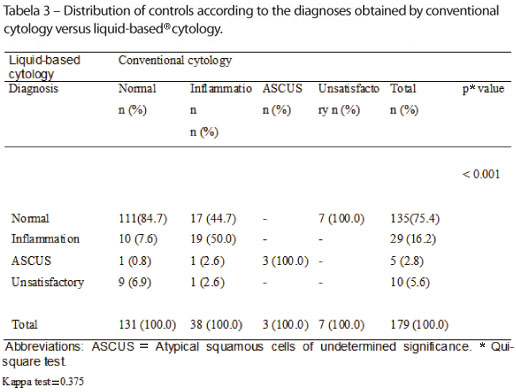
In the case group, conventional cytology and liquid-based cytology showed diagnostic agreement with histopathology in 131 (76.2%), and 117 (67.3%) SCC cases, respectively. However, if HSIL diagnoses - which corresponds to carcinoma in situ - were considered positive for disease, those numbers would incresase to 167 (97.1%) and 166 (955%), respectively. Thus, in conventional cytology 5 cases did not correspond to the histopathologic result; in liquid-based® cytology 8 cases did not agree with the histopathologic diagnoses (Table 1).
Among the cases, the agreement between the two cytologic methods was weak (Kappa= 0.178), with sensitivity= 96.9% (IC= 95%: 92.5% to 98.8%); specificity= 75.0% (IC= 95%: 21.9% to 98.7%); positive predictive value= 99.4%; negative predictive value= 37.5%, and accuracy= 96.3% (IC=95%: 92.5% to 98.5%). The results classified as SCC and HSIL were considered positive; the remainder were considered negative, and the unsatisfactory were excluded (Table 2).
In the control group, the agreement between the two cytologic methods was very weak (Kappa= 0.375), with sensitivity= 91.0% (IC= 95%: 84.1% to 95.2%); specificity= 57.5% (IC= 95%: 41.0% to 72.6%); positive predictive value= 86.7% (IC= 95%: 79.3% to 91.8%); negative predictive value= 67.6% (IC= 95%: 49.4% to 82.0%) and accuracy= 82.7% (IC= 95%: 76.3% to 88.0%). The results classified as normal were considered positive; the remainder were considered negative, and the unsatisfactory were excluded (Table 3).
Conventional cytology and liquid-based cytology proved to be able to identify and classify cellular alterations characteristic of malignancy. Therefore, they are valuable as auxiliary diagnostic methods. When compared to each other, they showed a high sensitivity and reasonable specificity, conventional cytology being more reliable. The latter was defended and largely used by Mao34, and according to Vidal and Silva7, if used appropriately, it has an excellent sensitivity and specificity when compared to histolopathologic diagnoses.
Some authors7,8,26, defend the use of cytology as a screening method for prevention and early diagnosis of oral cancer. Sciubba5 further35 mentions the computer-assisted exfoliative cytology as an accurate method for detecting premalignant and malignant buccal lesions.
Gynther, Rozell and Heimdahl36 cite direct buccal microscopy as a method for selecting areas to be submitted to cytology and biopsy. Moreover, Sciubba35 mentions the need to carry out studies to evaluate the sensitivity and specificity of oral scan laboratories inc. (Oral CDX). This is a computer-assisted method for the analysis of exfoliative cytology material, which adds to clinical examination in the differentiation of premalignant and malignant alterations found in "benign" lesions, the purpose being to find carcinomas of innocuous appearance, at the most curable and early stages.
The advantages of using conventional cytology in the oral mucosa, similarly to the uterine cervix, are its low cost, good patient tolerability, and easy applicability to large populations. The disadvantages are the number of unsatisfactory cases on account of technical reasons which depend on training in collect, fixation and sample preparation. In spite of its merits, one can not ignore the false-negative results. Furthermore, there are cases with cytomorphological alterations of innacurate diagnostic resolution. Liquid-based cytology has been considered an important alternative for improving cytology sensitivity, as it decreases cell loss during sample preparation, and provides a better cell distribution. In addition, it allows the use of molecular cytopathology techniques such as in situ hibridization, immunohistochemical tests, and determination of nucleic acids in molecular biology27. The best performance of Liquid-based cytology is achieved with a high quality presentation: clear bottom, good distribution of cells, ease in distinguishing individualized cells, and good cell preservation. However, it lacks the specificity of conventional cytology (Figures 2,3, 4 and 5).
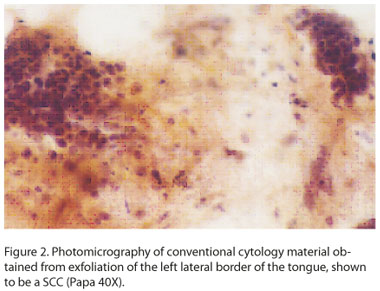
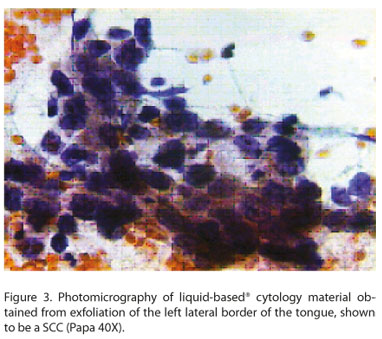
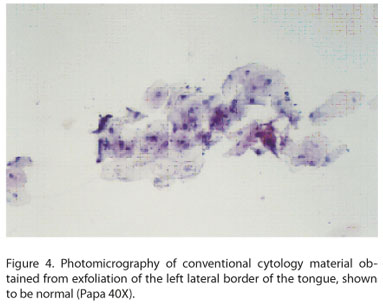
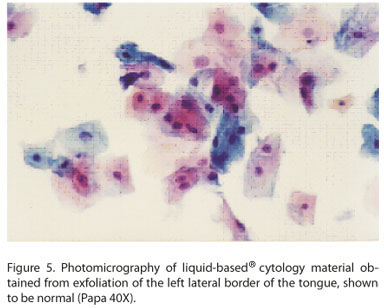
The acceptance and collaboration of the patients enrolled in this study, as well their interest (also mentioned by Vidal et al8) in the subject explored, demonstrate that the population wants and needs health education, in order to take better care of themselves and consequently have a higher quality of life.
CONCLUSION
Conventional cytology and liquid-based cytology demonstrated a diagnostic concordance with histopathology of more than 90%. Therefore, if properly indicated and executed, they can be routinely used as complementary diagnostic methods.
When compared to each other, conventional cytology and liquid-based cytology showed a high sensitivity and reasonable specificity, conventional cytology having higher specificity.
ACKNOWLEDGEMENTS
The authors thank all the participating patients, the professionals who help develop this work, and Cancer Hospital of Pernambuco, University of Pernambuco, National Health Foundation and Laboratory Digene of Brazil for the support given to this study.
REFERENCES
1. Bernier, j. l. Clinical features of early malignant growth of the oral cavity. In: BURKET, L. W. Symposium on the interrelationship of oral and systemic disease. Philadelphia, ed Dental Clinics of Nort America, Saunders. 1958. p, 325-333. [ Links ]
2. Waldron, C. A . Oral ephitelial tumors. In: GORLIN, R. J. e GOLDMAN, H. M. Oral ephitelial tumors eds. Thoma's Oral Patolog. St. Louis, Mosby. 1970. v.2. cap. 19 p.801-860. [ Links ]
3. Barbosa, J. F. e Fonseca, E. P. Câncer bucal: diagnóstico, tratamento e reabilitação. Ministério da Saúde – Divisão Nacional de Câncer. Programa Nacional de Controle do Câncer. 1972. 20p. [ Links ]
4. Catanzaro Guimarães, S. A . Patologia básica da cavidade bucal. Rio de Janeiro, Guanabara Koogan, 1982. 419p. [ Links ]
5. Scully, C.; Porter, S. ABC of oral health. Oral cancer. BMJ. v. 321, p. 97-100. 2000. [ Links ]
6. MacFarlaneE, G. J.; Sharp, L.; Porter, S. e Franceschi, S. Trends in survival from cancers of the oral cavity and pharynx in Scotland: a clue as to why the disease is becoming more common? Br. J. Cancer. v. 72 n. 9, p. 568-576. Mar. 1996. [ Links ]
7. Vidal, A . K. L. e Silva, J. F. Correlação cito-histopatológica e aplicabilidade do corante azul de toluidina a 2% em lesões de mucosa bucal. Dissertação de Mestrado. Revista do CRO/PE. V. 2 n. 1, p. 59-72.1999. [ Links ]
8. Vidal, A. K. L. ; Silvera, R. C. J.; Soares, E. A.; Caldas Júnior, A. F.; Cabral, A. C.; Souza, E. H. A.;Lopez, R. M. Prevenção e diagnóstico precoce do câncer de boca- uma realidade no Distrito Sanitário IV- Recife/ PE. Pesquisa Odontológica Brasileira v. 17 n. 2, p. 31. Ago. 2003. [ Links ]
9. Papanicolaou, G. N. Some improved methods for staing vaginal smears. J. Lab. Clín. Med. v. 16, p. 1200-1205. 1941. [ Links ]
10.Blank, H. et al. Cytologic smears in diagnosis of herpes simplex, herpes zoster e varicella. JAMA. v. 146 n. 15, p. 1410-1412. 1951. [ Links ]
11. Peters, H.; Rijsinghani, K. The cytologic interpretation of the mouth smear. J. Indian Med Assoc v. 27 n. 7, p. 231-236. 1956. [ Links ]
12. Araújo, N. S. Diagnóstico citológico de lesões da mucosa oral. Revista Brasileira de Cirurgia. v. 49 n. 5, p. 350-352. 1965 [ Links ]
13. Nowakovski , S. et al. Manifestations of viral infeccions in exfoliated cells. Acta Cytol. v. 35 n. 5, p. 416-419. 1981. [ Links ]
14. Burns, J. C. Diagnostic methods for herpes simplex infection: a review. Oral Surg. Oral Med. Oral Pathol. v. 50 n. 4, p. 346-349. 1980. [ Links ]
15. Marcucci, G.; Araújo, N. S. Citologia esfoliativa In: TOMMASI, A. F.; GRARRAFA, V. Câncer Bucal. São Paulo. Medisa. 1980. p.393-407. [ Links ]
16. Mercure, J. L. Cytodiagnosis et cancers buccaux. Rev. D'Odontologie. v. 10, p. 157-160. 1981. [ Links ]
17. Novelli, M. D. et al. Estudo comparativo entre a citologia esfoliativa e os achados clínicos de 1498 pacientes. Revista da APCD v. 35 n. 5, p. 416-419. 1981 [ Links ]
18. Barrett, A. P. et al. The value of exfoliative cytology in the diagnosis of oral herpex simplex infection in immunosupressed patients. Oral Surg. Oral Med. Oral Pathol. v. 62 n. 2, p. 175-178. 1986 [ Links ]
19. Persoglia, J. Citologia exfoliativa normal y Patologia de la mucosa bucal. Grinspan, D. Ed. Mundi S. A. C. I. F. Buenos Aires, 1987. p. 459-471. [ Links ]
20. MacLeod, R. I.; Soames, J. V. Morphological and morphometric studies of exfoliated oral squames from chronic inflammatory oral ulcers using light and scanning electron microscopy. British Journal of Oral and Maxillofacial Surgery. v. 33, p. 86-89. 1995. [ Links ]
21. Vaillant J. M. Dépistage et diagnostic des carcinomas épidermöides de la muqueuse búchale (CB). Que Pert-on conclure aujourd'hui du rôle respectif du frottis cytologique et de la biopsia? Bull. Acad. Natle. Med. v. 178 n. 2, p. 233-247. février, 1994. [ Links ]
22. Sposto, M. R.; Scully, C.; De Almeida, O. P.; Jorge, J.; Graner, E.; Bozzo, L. Oral paracoccidioidomycosis a study of 36 south american patients. Oral Surg Oral Med Oral Pathol v. 75 n. 4, p. 461-465. Apr. 1993 [ Links ]
23. Ogden, G. R.; Leigh, I.; Chisholm, D. M.; Cowpe, G.; Lane, E. B. Exfoliative cytololy of normal oral mucosa. Acta Cytologica. v. 40 n. 5, p. 933-936. 1996. [ Links ]
24. Ogden, G. R.; Cowpe, J. G.; Wight, A. J. Oral exfoliative cytology: review of methods of assessment. J. Oral Pathol. Med. v. 26, p. 201-205. 1997. [ Links ]
25. Vidal, A . K. L.; Caldas Júnior, A . F.; Mello, R. J. V.; Brandão, V. R. A .; Rocha, G. I.; Taromaru, E. Human papillomavirus (HPV) detection in oral carcinomas. J. Bras Patol Med Lab v.40 n.1, p. 21-26, janeiro/fevereiro, 2004. [ Links ]
26.Christian, D. C. Computer-assisted analysis of oral brush biopsies at oral cancer screening program. JADA v. 1333, p. 357-362. 2002. [ Links ]
27. Dôres, G. B.; Taromaru, E. Sistema DNA-CITOLIQ® - A Citologia em Nova Era - Manual Técnico. ©Digene do Brasil. São Paulo, 2003. 120p. [ Links ]
28.Brasil. Ministério da Saúde.Estimativas da Incidência e Mortalidade por Câncer no Brasil. 2010. Rio de Janeiro – INCa / Pró-Onco, 2010. [ Links ]
29. Sampaio, G. Anatomia Aplicada à Odontologia. Recife: EDUPE, 2001. p.347-369. [ Links ]
30. Galbarthe; Shimoda, T.; Haainaut, P.; Nakamura, Y.; Field, J. K.; Inove, H. Scamous cell carcinoma of the esophagus in: HAMILTON, S. R e AALTONE, L. A. World Health Organization Classification of Tumors. Pathology and Genetics of Tumors of the Digest System. Ed. IARC. Press Lion, 2000. p. 9-11 [ Links ]
31. MacDonald, D. G. Tumors of the Oral Cavity. In: Fletcher, C. D. N. Diagnostic histopatology of Tumors. Ed. Churchil Living Stone. London. 2000. p. 209-230. [ Links ]
32. Andrade, A. L. S. S.; Zicker, F. Métodos de investigação epidemiológica em doenças transmissíveis: volume I Brasília: Organização Pan-Americana de Saúde: Fundação Nacional de Saúde, 1997. 182p. [ Links ]
33. Kuffer, R.; Lombardi, T. Premalignant lesions of the oral mucosa. A discussion about the place of oral intrepithelial neoplasia (OIN). Oral Oncol. v. 38 n. 2, p. 125-130. Feb. 2002. [ Links ]
34. Mao, E. J. Prevalence of human papilomavirus 16 and nucleolar organizer region counts in oral exfoliated cells from normal and malignant epithelia. Oral Surg Oral Med Oral Pathol Oral Radiol Endod v. 80 n.3, p. 320-329. Sep. 1995. [ Links ]
35. Sciubba, J. J. Improving detection of precancerous and cancerous oral lesions. JADA v. 130, p.1445-1456. 1999. [ Links ]
36. Gynther, G. W.; ROZELL, B.; HEIMDAHL, A . Direct oral microscopy and its value in diagnosing mucosal lesions. A pilot study. Oral Surg Oral Med Oral Pathol Oral Radiol Endod v. 90 n. 2, p. 164-170. 2000. [ Links ]
 Endereço para correspondência
Endereço para correspondência
Aurora Karla de Lacerda Vidal
aurorakarla@gmail.com
Recebido para publicação: 16/02/11
Aceito para publicação: 21/02/11













